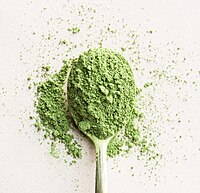
High-speed identification system for fresh tea leaves based on phenotypic characteristics utilizing an improved genetic algorithm.
Sign Up to like & getrecommendations! Published in 2022 at "Journal of the science of food and agriculture"
DOI: 10.1002/jsfa.12047
Abstract: BACKGROUND High-quality tea requires leaves of similar size and tenderness. The grade of the fresh leaves determines the quality of the tea. The automated classification of fresh tea leaves improves resource utilization and reduces manual… read more here.
Keywords: tea leaves; genetic algorithm; fresh tea; tea ... See more keywords

Fabrication of green composite fibers from ground tea leaves and poly(lactic acid) as eco-friendly textiles with antibacterial property
Sign Up to like & getrecommendations! Published in 2021 at "Journal of Material Cycles and Waste Management"
DOI: 10.1007/s10163-021-01269-6
Abstract: This work aims to prepare bio-based polymer composite fiber using poly(lactic acid) (PLA) and ground tea leaves (GTL) as a matrix and bio-based filler, respectively, via the melt-spinning process. The masterbatch obtained from PLA and… read more here.
Keywords: poly lactic; ground tea; lactic acid; composite fibers ... See more keywords

The separation of diafenthiuron in fresh tea leaves via efficient subcritical fluid approach
Sign Up to like & getrecommendations! Published in 2017 at "Chemical Papers"
DOI: 10.1007/s11696-017-0202-z
Abstract: In this study, we firstly employed response surface methodology to optimize the extraction conditions for separating diafenthiuron from fresh tea leaves via subcritical fluid extraction. Besides, the surface structure was characterized before and after the… read more here.
Keywords: subcritical fluid; extraction; tea leaves; diafenthiuron fresh ... See more keywords

Copper, Manganese, Zinc, and Cadmium in Tea Leaves of Different Types and Origin
Sign Up to like & getrecommendations! Published in 2017 at "Biological Trace Element Research"
DOI: 10.1007/s12011-017-1140-x
Abstract: Concentrations of selected metals (Cu, Mn, Zn, Cd) in tea leaves were investigated. Samples included black, green, and other (red, white, yellow, and oolong) teas. They were purchased on a local market but they covered… read more here.
Keywords: copper manganese; tea leaves; tea; zinc cadmium ... See more keywords

Chemical composition of an insecticidal hydroalcoholic extract from tea leaves against green peach aphid
Sign Up to like & getrecommendations! Published in 2018 at "International Journal of Environmental Science and Technology"
DOI: 10.1007/s13762-018-2177-x
Abstract: The development of botanical insecticides for pest control in agriculture is an important challenge nowadays. The plant extract derived from tea leaves was evaluated for its insecticidal activity toward green peach aphid. Evaluation of the… read more here.
Keywords: peach aphid; green peach; hydroalcoholic extract; tea leaves ... See more keywords

Elemental characterization of Japanese green tea leaves and tea infusion residue by neutron-induced prompt and delayed gamma-ray analysis
Sign Up to like & getrecommendations! Published in 2017 at "Arabian Journal of Chemistry"
DOI: 10.1016/j.arabjc.2012.11.008
Abstract: Abstract The determination of mineral compositions of Japanese green tea leaves was carried out using a combination of PGA (neutron-induced prompt gamma-ray analysis) and INAA (instrumental neutron activation analysis). Due to the nondestructive, multi-element analytical… read more here.
Keywords: green tea; infusion; analysis; tea leaves ... See more keywords

Identification of d-amino acids in tea leaves.
Sign Up to like & getrecommendations! Published in 2020 at "Food chemistry"
DOI: 10.1016/j.foodchem.2020.126428
Abstract: During manufacturing processes and in the storage period of tea, amino acids may undergo enantiomeric isomerization, converting their l- to d-forms. To examine the hypothesis, a method was developed for the analysis of the enantiomers… read more here.
Keywords: acids tea; identification amino; amino acids; tea leaves ... See more keywords

Investigation of epigallocatechin-3-O-caffeoate and epigallocatechin-3-O-p-coumaroate in tea leaves by LC/MS-MS analysis.
Sign Up to like & getrecommendations! Published in 2017 at "Food research international"
DOI: 10.1016/j.foodres.2017.09.086
Abstract: (-)-Epigallocatechin-3-O-gallate (EGCG), the major catechin present in green tea, exhibits potent antioxidant activity. We thereby investigated the presence of unknown components bearing the (-)-epigallocatechin (EGC) moiety in fresh tea leaf samples. Initially, liquid chromatography tandem… read more here.
Keywords: epigallocatechin coumaroate; epigallocatechin caffeoate; tea leaves; egcpca egcca ... See more keywords

A comparison of the phenolic composition of old and young tea leaves reveals a decrease in flavanols and phenolic acids and an increase in flavonols upon tea leaf maturation
Sign Up to like & getrecommendations! Published in 2020 at "Journal of Food Composition and Analysis"
DOI: 10.1016/j.jfca.2019.103385
Abstract: Old tea leaves (OTL), which are normally discarded as agricultural waste, are potential sources of tea phenolic compounds. However, little details are known about their phenolic composition. In this study, the phenolic profiles of OTL… read more here.
Keywords: tea leaves; young tea; tea; maturation ... See more keywords

Polyphenolic extracts from Wushan tea leaves attenuate hepatic injury in CCl4-treated mice
Sign Up to like & getrecommendations! Published in 2020 at "Journal of Functional Foods"
DOI: 10.1016/j.jff.2020.103826
Abstract: Abstract The current study aimed to investigate the protective effects of polyphenolic extracts from Wushan tea leaves (WST-PE) on the liver of Kunming mice subjected to CCl4. Flavonoids, flavanones, and flavonols were major components of… read more here.
Keywords: extracts wushan; tea leaves; wushan tea; polyphenolic extracts ... See more keywords

Nitric oxide mediates brassinosteroid-induced flavonoid biosynthesis in Camellia sinensis L.
Sign Up to like & getrecommendations! Published in 2017 at "Journal of plant physiology"
DOI: 10.1016/j.jplph.2017.04.005
Abstract: Flavonoids are one of the key secondary metabolites determining the quality of tea. Although exogenous brassinosteroid (BR), a steroidal plant hormone, can stimulate polyphenol biosynthesis in tea plants (Camellia sinensis L.), the relevance of endogenous… read more here.
Keywords: biosynthesis; tea leaves; tea; flavonoid biosynthesis ... See more keywords